SAMSCA® is indicated for the treatment of clinically significant hypervolemic and euvolemic hyponatremia:
Serum sodium <125 mEq/L or less marked hyponatremia that is symptomatic and has resisted correction with fluid restriction, including patients with heart failure and Syndrome of Inappropriate Antidiuretic Hormone (SIADH)
- Patients requiring intervention to raise serum sodium urgently to prevent or to treat serious neurological symptoms should not be treated with SAMSCA
- It has not been established that raising serum sodium with SAMSCA provides a symptomatic benefit to patients
The patient selection guide below can help you identify which patients may be appropriate for SAMSCA.
SAMSCA is contraindicated in the following conditions:
- Use in patients with Autosomal Dominant Polycystic Kidney Disease (ADPKD) outside of FDA-approved REMS
- Urgent need to raise serum sodium acutely
- Inability of the patient to sense or appropriately respond to thirst
- Hypovolemic hyponatremia
- Concomitant use of strong CYP 3A inhibitors
- Anuric patients
- Hypersensitivity (e.g. anaphylactic shock, rash generalized) to tolvaptan or its components

Review clinical cases about patients with hyponatremia in heart failure and hyponatremia in SIADH



